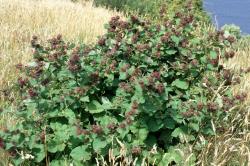- Taxon
- Weed
- Gallery
- ≡ Lappa minor Hill (1762)
Plants openly branched, 1–1.5 m tall. Stems grooved, with sparse to dense cobwebby eglandular and subsessile glandular hairs, rarely glabrous or farinose. Basal lvs deltoid to broadly deltoid, green and sparsely hairy above, whitish and densely felted beneath, (15)–25–40–(55) × (10)–13–30–(35) cm; base cordate; apex subacute to obtuse; margin crenate to bluntly dentate with apiculate vein endings; petioles hollow. Upper lvs similar to basal, becoming smaller. Infl. racemose; peduncles 0–1–(3) cm long. Capitula (12)–15–20 × (14)–20–30 mm. Involucral bracts straw yellow, greenish or purplish, glabrous or with sparse to dense cobwebby hairs; margins with short, stiff, tapered, forwardly directed denticles, at least on the innermost bracts. Florets = or > involucral bracts; corolla reddish purple. Achenes 5–7 mm long; pappus 1.5–3.5 mm long.
[From: Webb et al. (1988) Flora of New Zealand. Volume 4.]
| Category | Number |
|---|---|
| Exotic: Fully Naturalised | 1 |
| Total | 1 |
Flowering: Jan.–Apr.; Fruiting: Feb.–May.




